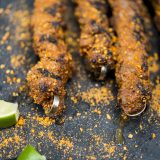As a child visiting Nigeria, Kwame Onwuachi desperately wanted to eat beef suya, the country’s ubiquitous grilled street snack seasoned with ground nuts and spices. Except his grandfather forbade it, disapproving of street food.
“It actually made it more appealing,” he says.
Years later, the “Top Chef” alumnus and former cook at New York’s Eleven Madison Park returned to Nigeria and immediately sought out the formerly forbidden delight, making friends with a baggage guy at the airport who took him to his favorite suya spot.
The street vendor scene reminded Onwuachi of Thailand: “A lot of darkness and then, out of nowhere, a pocket of lights with many stalls selling the same thing, but with their own twist.”
There was a man, a grill, a counter covered with newspaper. “One, please!”
“The cook took the meat off a weathered cutting board that looked older than me and sliced it into strips. With the knife, he scooped it off the board and onto the newspaper. He then took a shaker and covered the steak with the seasoning, liberally, like a blanket of snow. He topped it with chopped raw red onions and bright red tomatoes.”
“I quickly grabbed it, almost forgetting to pay him, and instantly put it in my mouth. It was probably one of the most spiciest things I consumed at the time, but the depth of flavor kept me going back for more. I was sweating and eating, and sweating and eating. I could really taste the ground nut, ginger and cayenne. It was a beautiful thing and I couldn’t wait to get back to the States to try my hand at making it myself.”
Eaten on the spot with burning fingers and tongue or carried away wrapped in newspaper, suya is everywhere in Nigeria, popular both in the Muslim north and Christian south. It is usually made with thin strips of beef, though it can be made with chicken or organ meats like kidney and tripe. It has even been featured as a pizza topping at one restaurant.
Suya fits into a meat-on-a-stick universe that stretches from Greek souvlaki to Indonesian satay. What sets it apart is its spice rub, typically a blend of ground peanuts, red pepper and other seasonings. Though origin stories vary, suya is said to have begun skewered on swords and daggers, then hung above the campfires of tribal nomads.
Nigerians rarely cook suya at home. Why bother when there’s a nearby stand run by an experienced suya man?
But we loved the flavor and ease of the dish and knew it would be a hit come grill season. At Milk Street, we worked to create a version easily made by American home cooks.
We started with the cut of meat. Suya is somewhere between chunky kebabs and skinny satay, and the meat gets pushed together when skewered. Flat-iron steak was easily cut into long, ½-inch-thick strips. It also had the best texture—tender, not mushy—and cooked consistently on the grill. (Blade steak, also called top blade, worked too, but required removing a line of gristle found at the center of each piece.)
For the rub, unsalted, dry-roasted peanuts were the best choice. Ground ginger was a must, as were sweet paprika and onion and garlic powders. Suya is known for its heat, and we brought ours with cayenne. Fear not—the amount is easily adjusted for milder tastes. Salting the beef and letting it sit before applying the seasoning helped its flavor better penetrate the meat.
Making the spice rub was a simple matter of throwing all the ingredients into a food processor and whirling until the peanuts were ground. We reserved some for serving, then added oil to make a paste, which we massaged into the meat before threading it onto skewers for grilling.
The results were good but didn’t have quite the juicy, charred flavor we were after. Then we hit on the idea of adding brown sugar to the spice mix. The sugar caramelized beautifully, developing a brown crust and intensifying the meat’s flavor. A splash of lime juice at the finish added tang, and a final sprinkle of the reserved spice rub lent a jolt of fresh flavor.
Cucumber, tomato, cabbage and onion are traditional and refreshingly cool complements to the spicy beef. They are typically served on the side, almost as a deconstructed salad.
Returned from his travels, Onwuachi put his own spin on suya, retaining the spice of the original but reimagining the accompanying tomatoes and onions—traditionally served in big, not-all-that-palatable, raw chunks—as a tomato soubise, a twist on the classic white sauce based on onion puree.
A proud champion of Nigerian cooking, Onwuachi—who was born and raised in the Bronx but spent time in Nigeria as a child—doesn’t see his mission as introducing Americans to Nigerian food so much as revealing to them the Nigerian food they already know.
And not just Nigeria. Many of the dishes we think of as American fare have their origins in Africa, brought here by slaves. Senegalese chef Pierre Thiam has talked about the similarities between gumbo and soupou kanja, an okra stew from his homeland.
“Where do you think jambalaya came from? Nigerian jollof rice,” Onwuachi says. “Gumbo? That’s West African okra stew. It’s right under our noses. I want to help bring it to the forefront.”




